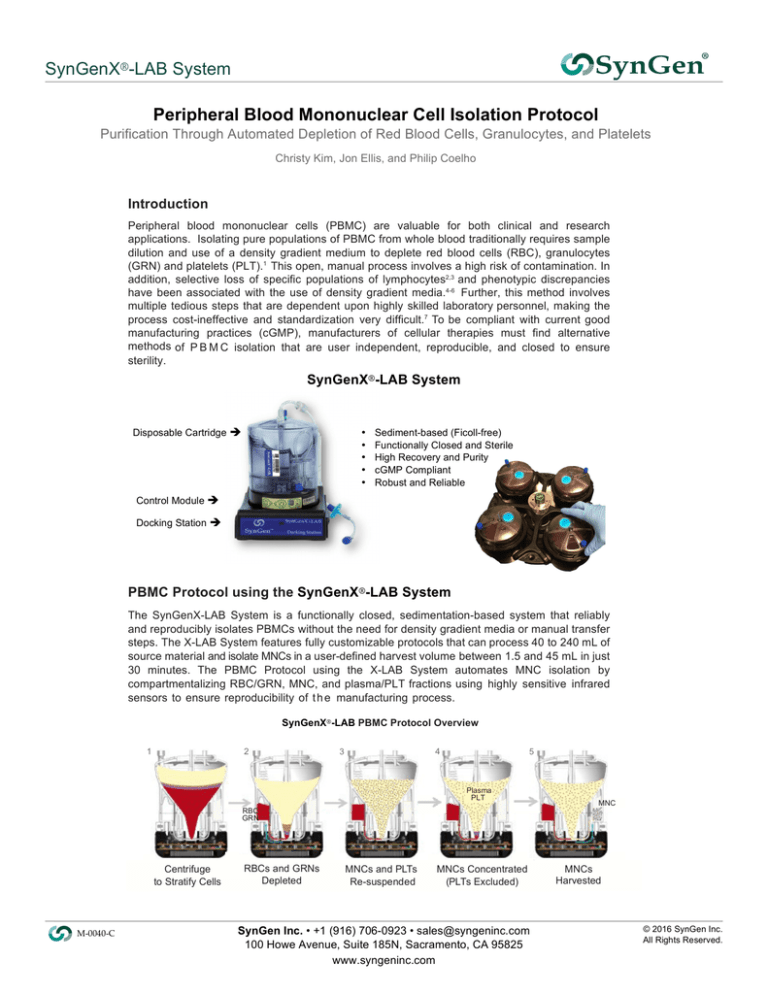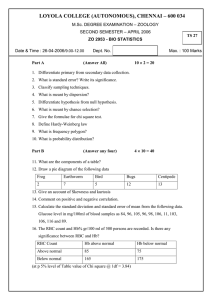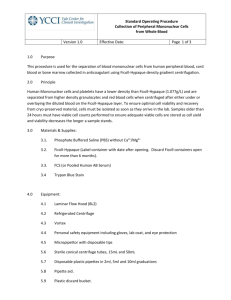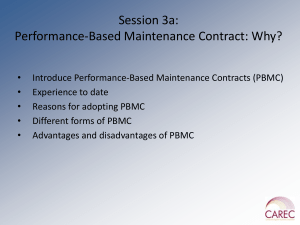
SynGenX®-LAB System
Peripheral Blood Mononuclear Cell Isolation Protocol
Purification Through Automated Depletion of Red Blood Cells, Granulocytes, and Platelets
Christy Kim, Jon Ellis, and Philip Coelho
Introduction
Peripheral blood mononuclear cells (PBMC) are valuable for both clinical and research
applications. Isolating pure populations of PBMC from whole blood traditionally requires sample
dilution and use of a density gradient medium to deplete red blood cells (RBC), granulocytes
(GRN) and platelets (PLT).1 This open, manual process involves a high risk of contamination. In
addition, selective loss of specific populations of lymphocytes2,3 and phenotypic discrepancies
have been associated with the use of density gradient media.4-6 Further, this method involves
multiple tedious steps that are dependent upon highly skilled laboratory personnel, making the
process cost-ineffective and standardization very difficult.7 To be compliant with current good
manufacturing practices (cGMP), manufacturers of cellular therapies must find alternative
methods of P B M C isolation that are user independent, reproducible, and closed to ensure
sterility.
SynGenX®-LAB System
Disposable Cartridge è
•
•
•
•
•
Sediment-based (Ficoll-free)
Functionally Closed and Sterile
High Recovery and Purity
cGMP Compliant
Robust and Reliable
Control Module è
Docking Station è
PBMC Protocol using the SynGenX®-LAB System
The SynGenX-LAB System is a functionally closed, sedimentation-based system that reliably
and reproducibly isolates PBMCs without the need for density gradient media or manual transfer
steps. The X-LAB System features fully customizable protocols that can process 40 to 240 mL of
source material and isolate MNCs in a user-defined harvest volume between 1.5 and 45 mL in just
30 minutes. The PBMC Protocol using the X-LAB System automates MNC isolation by
compartmentalizing RBC/GRN, MNC, and plasma/PLT fractions using highly sensitive infrared
sensors to ensure reproducibility of t h e manufacturing process.
SynGenX®-LAB PBMC Protocol Overview
1
2
4
Plasma
PLT
RBC
GRN
Centrifuge
to Stratify Cells
M-0040-C
RBCs and GRNs
Depleted
MNCs and PLTs
Re-suspended
MNCs Concentrated
(PLTs Excluded)
SynGen Inc. • +1 (916) 706-0923 • sales@syngeninc.com
100 Howe Avenue, Suite 185N, Sacramento, CA 95825
www.syngeninc.com
MNC
MNCs
Harvested
© 2016 SynGen Inc.
All Rights Reserved.
SynGen®X-LAB System
Methods: To evaluate the performance of the PBMC
Protocol, 9 X-LAB Cartridges were loaded with peripheral
blood (mean volume 167.8±4.4 mL) less than 24 h postcollection. Cartridges were then mated with their preprogrammed Control Modules and placed in a 750 mL
swinging bucket centrifuge. The automated centrifugation
protocol involved:
1.
Centrifugation at 2000 x g for 20 min to sediment
the bulk RBC/GRN fraction
2.
Depletion of the bulk RBC/GRN fraction at 100 x g
for 5 min.
3.
C e n t r i f u g a t i o n at 2000 x g for 5 min to
sediment residual RBC/GRNs
4.
Depletion of residual RBC/GRNs at 100 x g for 1
min.
(Cartridges were then removed from the centrifuge, briefly
agitated to re-suspend MNCs and PLTs in the main
chamber, and returned to the centrifuge)
5.
Centrifugation at 1000 x g for 1 min to sediment
the MNCs, leaving the platelets suspended
6.
Centrifugation at 100 x g for 1.5 min to harvest the
purified MNC fraction
Results: The SynGen PBMC protocol generated MNC
recoveries of 94.5±4.0% while efficiently depleting PLTs
(88.9±4.6%), GRNs (80.3±3.9%), and RBCs (99.6±0.1%).
Conclusion
The PBMC Protocol using the SynGenX-LAB System
overcomes the limitations of traditional density gradient
separation by providing an automated, closed system that
isolates MNCs with high recoveries, viability and purity, and
that is compliant with cGMP.
Efficient depletion of unwanted cellular fractions is essential
for downstream assays and applications. For instance, in
positive magnetic activated cell selection (MACS) of CD34+
cells, high RBC, GRN and PLT contamination have been
shown to significantly reduce the purity and yield of CD34+
cells due to nonspecific binding and sequestering of cells of
interest in clumps and clots.8-10 Further, if the isolated MNCs
are to be cryopreserved, RBC contamination impairs MNC
function following thawing, as RBC are prone to lysis.11,12
The adoption of the SynGenX-LAB PBMC Protocol reduces
process variability while optimizing the recovery of
physiologically relevant cell populations, providing
performance and consistency suitable for clinical scale
applications.
Ordering Information
Product
X-LAB Disposable Cartridge
Catalog No.
SGI-0380
X-LAB Control Module
SGI-0046-03
X-LAB Docking Station
SGI-0120-03
M-0040-C
SynGen PBMC Protocol Results
94.5
80
n=9
60
40
20
0
-80
-100
-99.6
References
Boyum, A. (1968). “Isolation of mononuclear cells and granulocytes from human blood. Isolation of monuclear cells by one
centrifugation, and of granulocytes by combining centrifugation and sedimentation at 1 g.” Scand J Clin Lab Invest Suppl
97: 77-89.
Hokland, P. and I. Heron (1980). “The Isopaque-Ficoll meth- od
re-evaluated: selective loss of autologous rosette-forming
lymphocytes during isolation of mononuclear cells from human
peripheral blood.” Scand J Immunol 11(3): 353-356.
Hokland, P. and I. Heron (1980). “Analysis of the lymphocyte
distribution during Isopaque-Ficoll isolation of mononuclear
cells from human peripheral blood.” J Immunol Methods 32(1):
31-39.
Alexander, E. L., et al. (1978). “Quantitation of Fc receptors and
surface immunoglobulin is affected by cell isolation proce- dures
using plasmagel and ficoll-hypaque.” J Immunol Meth- ods
22(3-4): 263-272.
Lin, S. J., et al. (2002). “Expression of adhesion molecules on T
lymphocytes in young children and infants--a comparative study
using whole blood lysis or density gradient separation.” Clin Lab
Haematol 24(6): 353-359.
Romeu, M. A., et al. (1992). “Lymphocyte immunophenotyping
by flow cytometry in normal adults. Comparison of fresh whole
blood lysis technique, Ficoll-Paque separation and cryopreservation.” J Immunol Methods 154(1): 7-10.
Nilsson, C., et al. (2008). “Optimal blood mononuclear cell isolation procedures for gamma interferon enzyme-linked immunospot testing of healthy Swedish and Tanzanian subjects.”
Clin Vaccine Immunol 15(4): 585-589.
Hildebrandt, M., et al. (2000). “Immunomagnetic selection of
CD34+ cells: factors influencing component purity and yield.”
Transfusion 40(5): 507-512.
Reiser, M., et al. (2000). “High platelet contamination in progenitor cell concentrates results in significantly lower CD34+
yield after immunoselection.” Transfusion 40(2): 178-181.
Bruno, A., et al. (2002). “Positive selection of CD34+ cells by
immunoadsorption: factors affecting the final yield and hematopoietic recovery in patients with hematological malignancies
and solid tumors.” Transfus Apher Sci 26(2): 103-110.
Zhurova, M., et al. (2012). “Quality of red blood cells isolated
from umbilical cord blood stored at room temperature.” J Blood
Transfus 2012: 102809.
Hauck-Dlimi, B., et al. (2014). “The effect of cell concentrations
from different cell populations on the viability of umbilical blood
stem cells.” Clin Lab 60(10): 1635-1640.
SynGen Inc. • +1 (916) 706-0923 • sales@syngeninc.com
100 Howe Avenue, Suite 185N, Sacramento, CA 95825
www.syngeninc.com
© 2016 SynGen Inc.
All Rights Reserved.






